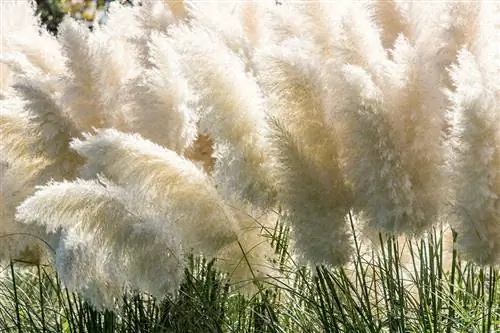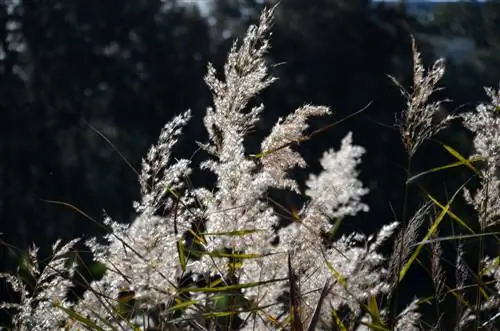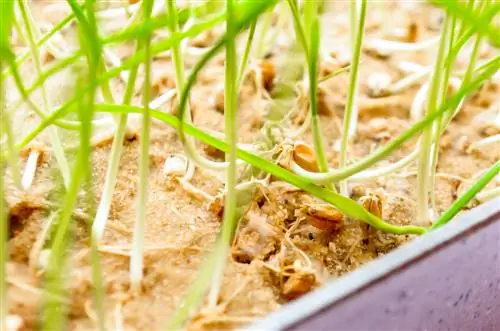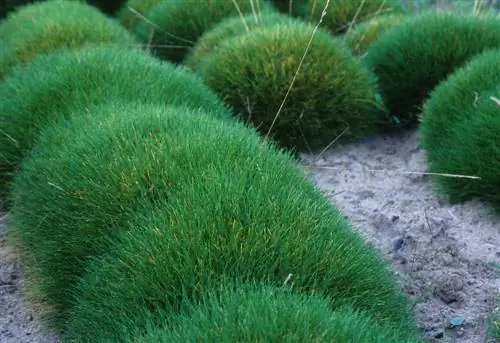- Author admin [email protected].
- Public 2023-12-16 16:46.
- Last modified 2025-06-01 06:02.
In the bed combined with other perennials or as a single plant in a pot - pampas grass is one of the most popular solitary perennials for the garden due to its decorative fronds. The flowers of pampas grass can be dried, dyed and made into wreaths and bouquets.

Plant Profile
Origin of pampas grass
Pampas grass is a clump-forming plant from the sweet grass family (Poaceae). Their tall growth and beautiful flowers enchant many hobby and landscape gardeners. The hardy plant originally comes from the South AmericanPampa grass landscape Its full name, 'American pampas grass' (Cortaderia selloana), is reminiscent of this.
In the large Pampas - which extends over large parts of Brazil, Uruguay, Paraguay, Chile and Argentina - the grass feels very comfortable in the loose sand and alluvial soils. For several years now, pampas grass has also been growing wild in Europe, Australia and North America.
Location and soil
From its origin you can quickly deduce what requirements pampas grass as an ornamental plant places on the location and soil. In the treeless pampas there is a lot ofdirect sunAnd theloose, butnutrient-rich soil allows water to drain away quickly . At the same time, it rains a lot there, although windy storms are rare.
In order to cultivate pampas grass as an ornamental plant, these location and soil conditions apply:
- Sunny or partial shade
- Protected from the wind
- Loose to sandy substrate
- Nutritious, humus-rich soil
- Damp, but never waterlogged
Pampas grass in a pot needs a good drainage layer to ensure permeability. In a bed, for example, the top of an embankment is a suitable location because the water flows down from there and does not collect at the roots.
read more
Appearance and height of pampas grass
Pampas grass has become established as a cultivated plant due to its unique beauty. While the impressivegrowth height of up to 250 centimeters makes an imposing impression, the fine flower panicles enchant with their lightness. The latter form in late summer and are often referred to as 'puschel' or 'wedel'. Their variety of colors ranges from white to golden brown to pink.

The narrow, curved leaves of the pampas grass, which are about 80 to 100 centimeters long, shimmer gray-green to blue-green. The foliage and flower stalks sprout like a perennial from a clump, which is colloquially known as the heart of the plant. If the grass grows well for a few years, the clump can reach a diameter of over 100 centimeters.
Development of pampas grass over the course of the year
A tiny pampas grass seed becomes a powerful plant within just a few years. Under the right conditions, a seedling will sprout and quickly spread its roots. At high temperatures, the pampas grass reaches its full height in the first year. Flowers, on the other hand, are very likely to only form from the second year onwards. The flowering period depends on the variety and ranges from July to November.
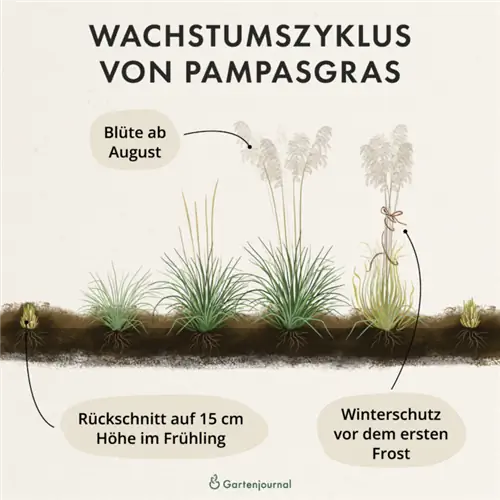
In mild winters, the pampas grass retains its green foliage. But often the leaves and stems dry up, turn yellow and have to be removed the next spring. During the cold season, the foliage, tied together, serves as natural winter protection. When it gets warmer again, growth starts again.
read more
Varieties and colors of pampas grass
The genus Pampas grass (Cortaderia) contains over20 different species Our ornamental plant, the American pampas grass, in turn has a huge variety of varieties. They differ in height, flowering time and color. While the latter characteristics are up to personal preference, the height of growth determines whether a variety is suitable for the container or the balcony.
read more
Small pampas grass
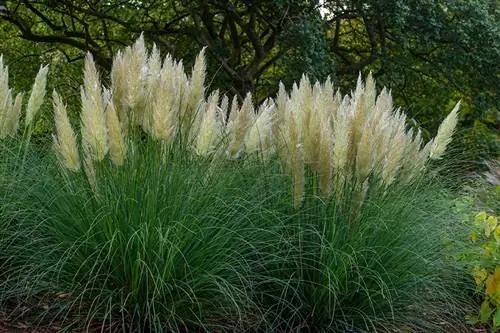
Small but mighty - Pumila is an absolute eye-catcher despite her size.
Plants under 150 centimeters are considered small varieties of pampas grass. They are suitable for the bucket and sometimes also for the balcony. In small gardens, these varieties also take up less space, so you don't have to go without the popular ornamental grass, even if you have little space.
| Name | Growth height | Flower color | Flowering time | Leaf Color |
|---|---|---|---|---|
| Pumila | 50-120 cm | white (silvery) | September to October | greygreen |
| Mini Silver | 50-100 cm | white | September to November | greygreen |
read more
Large pampas grass
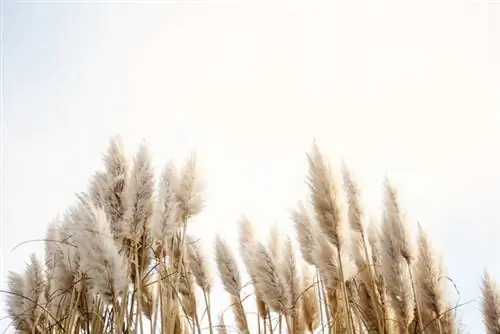
If there is a lot of space available in the garden and an eye-catching eye-catcher is desired, then a large variety of pampas grass is recommended. All plants that arehigher than 150 centimeters belong to this category. As a rule, they also produce the largest flowers.
| Name | Growth height | Flower color | Flowering time | Leaf Color |
|---|---|---|---|---|
| Aureolineata | 90 - 150 cm | silver white | September to October | golden green stripes |
| Silver Comet | 100 - 150 cm | white | August to November | grey-green, edged with white |
read more
White pampas grass
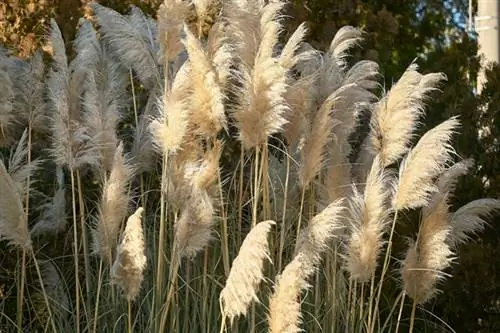
White pampas grass is one of the absolute favorites of hobby gardeners. The variety of varieties on offer is correspondingly large. Sometimes the white reaches brownish, sometimes silvery. As a rule, all flowers turn bronze in autumn. But even then it's a pretty eye-catcher.
| Name | Growth height | Flower color | Flowering time | Leaf Color |
|---|---|---|---|---|
| White Feather | 90 - 250 cm | silverywhite | September to October | greygreen |
| Compacta | 50 - 120 cm | yellowishwhite | September to October | strong green |
read more
Pink pampas grass
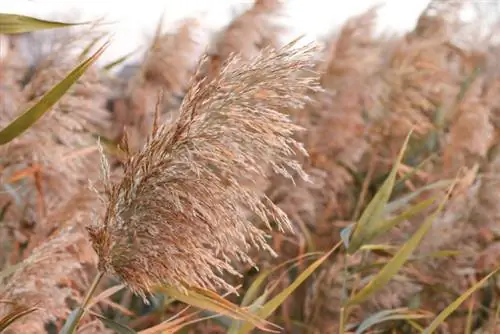
Pink pampas grass is even more exotic than the already striking white varieties. While it produces light pink to pink flowers in summer, beautiful copper-red to brownish fronds develop in autumn. The selection of varieties of the feminine-looking pampas grass is quite manageable.
| Name | Growth height | Flower color | Flowering time | Leaf Color |
|---|---|---|---|---|
| Pink Feather | 100 - 120 cm | light pink | September - November | greygreen |
| Scarlet Wonder | 150 - 250 cm | pink red | September - November | light green |
read more
Planting, replanting and replanting pampas grass
When planting in the pot and in the bed, there are a few things to consider so that the pampas grass quickly gets used to the new location. The ideal time to plant or transplant pampas grass islate spring It is recommended to soak the root ball in a bucket before planting.
Pampas grass in a pot
Pampas grass in a pot is possible and also very common. The advantages are that the plant remains relatively small and a pot with wheels is very mobile. A large plant pot with a minimum volume of 40 liters is essential. The nutrient-rich substrate must be loose and water-permeable. To do this, you can either use special ornamental grass soil from specialist retailers or humus-rich soil from the garden. If the latter is too clayey, it can be loosened up with sand.

Expanded clay or gravel is suitable as a drainage layer under the ground. A water-permeable fleece has proven to be useful between the bottom of the pot and the drainage layer. It prevents stones from blocking the holes in the bottom of the pot. These holes serve as an absolutely necessary water drain and should therefore always remain free. Because the pampas grass cannot tolerate waterlogging at all.
read more
Pampas grass in the bed
In the bed, care should be taken to ensure that the location is not deep (e.g. in a hollow). The planting hole should be at least 45 centimeters deep; the diameter should be twice as wide as the rootstock. The excavated material is stored laterally. The hole is filled with compost.
The seedling is placed in the middle of the hole. Depending on its strength, the excavated soil can first be mixed with sand or ornamental grass soil and then filled in the hole. Then tamp the soil well and water the plant. There is a planting distance of approximately 100 to 120 centimeters between two pampas grasses.
Transplanting pampas grass
Pampas grass should only be transplantedin the spring after pruning. Otherwise, the plant is difficult to move because of its sharp-edged leaves. All you need are gloves, a spade and some muscle strength. Wet soil is also recommended after a lot of rain, as moist soil is easier to work.
The spade is used to dig around the eyrie. The roots sometimes go very deep. Once the nest has been removed from the old hole, it can also be divided if desired. In both cases, the plant should be allowed to move into its new location quickly.
read more
Removing Pampas Grass
If the pampas grass no longer pleases or is in the way, it can be removed. To do this, proceed in the same way as transplanting, although you need to take less care. The root is dug out with a spade. It is quicker to use chemical agents to kill the plant. However, this is strongly discouraged as the soil will be permanently poisoned.
read more
Sowing and propagating pampas grass
Pampas grass can be easily propagated. Not about their own seed production, but about dividing the nest. If you want to extend the privacy screen or decorate other corners of the garden with the ornamental grass, that's no problem. By the way, freshly grown young plants and divided specimens make creative gifts for gardening lovers.
Sowing pampas grass
Pampas grass seeds are very similar to lawn seeds. However, since almost exclusively female plants are found in local gardens and parks, fertilization is very rare. Accordingly, it is usually not possible to obtain your own seeds. There is a large selection of seeds available in specialist retailers and online shops.

But sowing pampas grass requires a lot of materials and work. If you still want to make the effort, you should follow step-by-step instructions, as breeding is only successful under certain conditions. But the work is worth it: there is a greater variety of varieties available to self-growers and their own young plants are generally stronger than purchased seedlings.
read more
Dividing pampas grass
Dividing the nest turns out to be much easier and quicker. To do this, it is dug up with its rootsin spring and divided in the desired location with a spade. The resulting pieces can be replanted. The advantage of division is that a beautiful and he althy specimen is essentially 'cloned'. Because unlike sowing, the properties of divided pampas grass are identical to the original plant.
read more
Pampas Grass Care
Pampas grass is considered easy to care for and undemanding. However, there are useful recommendations that will support the growth of the plant and the formation of flowers. This includes cutting, using fertilizer and correct watering. In addition, winter protection is an important care measure in our latitudes.
Cutting pampas grass
Pruning pampas grass is primarily a cosmetic matter. But reaching for secateurs at the wrong time can have dire consequences for the plant. The foliage serves as an insulating protective shield in winter. Therefore, pampas grass should only be cut in late spring when frost is no longer expected.
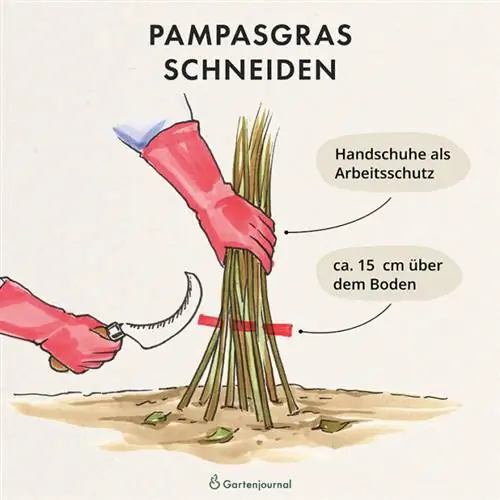
The stalks are cut 15 cm above the ground with secateurs, grass shears or scythe. If green leaves survived the winter, they do not need to be removed. Instead, with gloves on, dried and yellow stalks can be pulled out. Otherwise, use electric or manual pruning shears to place them about ten centimeters above the clump and remove all leaves.
read more
Fertilize pampas grass
Pampas grass needs fertilizer to provide nutrients to the large flowers. When planting, somecompost should already be put into the planting hole. The ornamental grass can then be fertilized regularly. Organic fertilizer such as compost is completely sufficient. You should be careful not to fertilize too much. In addition to compost, it is also possible to use horn shavings, coffee grounds and organic liquid fertilizer.
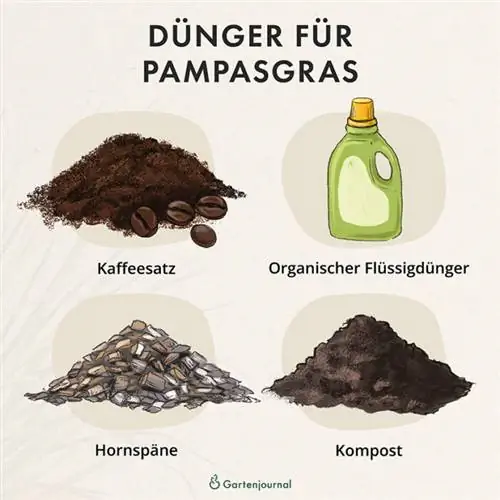
The addition of fertilizer is even more important in the bucket, as the irrigation water constantly flushes out minerals. Because the microorganisms that decompose the organic fertilizer are only present in small quantities in the potting soil, it is recommended to add liquid fertilizer to the pot. There are specific varieties for ornamental grasses and even pampas grass. These are used according to the dosage instructions.
read more
Watering and Drainage
Due to the permeable substrate in which pampas grass likes to grow, regular watering is necessary. If there is no rain, a lot of watering is required in the warm spring and summer. The rule of thumb is: ten liters per watering process. This is especially true for potted plants. These are watered until the water comes out of the holes again.
If you feel like the soil is too wet, watering should be reduced. Because pampas grass cannot cope with waterlogging. On the contrary - it survives dry phases much better. When watering, care should also be taken not to pour into the clump, but around it. Otherwise, rot may occur.
Overwintering pampas grass
Pampas grass is considered hardy. It can even withstand temperatures as low as -17°C. What he finds particularly difficult in Germany is the cold, wet conditions. Rainwater collects in the unprotected horst and freezes at low temperatures. This is very damaging to the pampas grass. In addition, long-term moisture poses a risk of rot.
read more
Overwinter pampas grass in a pot
Before the first frost in October or November, pampas grass in the pot must be well wrapped and insulated. The stalks and stems are tied together at the top to form a knot. Rainwater rolls off the sides and doesn't hit the heart. AdditionalLeaves on the ground also protects against cold and wet.
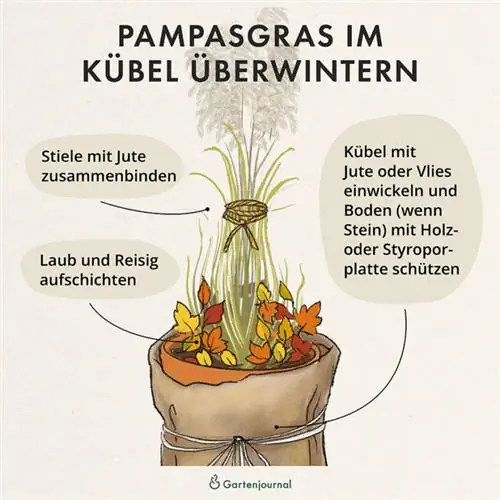
Overwinter pampas grass in the bed
A similar procedure also applies to the pampas grass in the bed. Grasp the stalks and stems and tie them together several times if necessary. The bottom around and the sides of the head are covered with brushwood and leaves. So the pampas grass stays until late spring: an eye-catcher of a different kind.
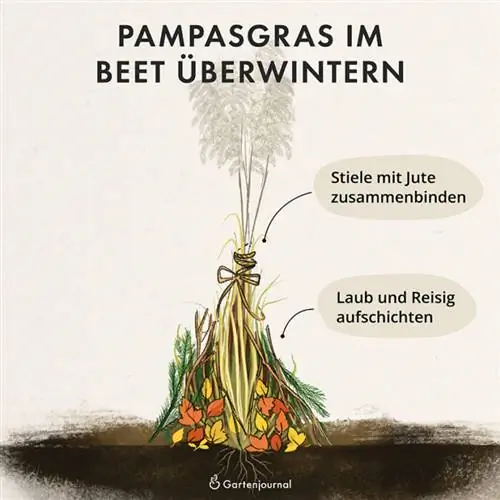
Tying and braiding pampas grass
The braided pampas grass sculptures are more stylish, but require significantly more work. An artistic trend with function - because as long as the water flows off the sides, the plant remains protected in winter. If the normal hairstyle is too boring, you will find a we alth of creative ideas on social media.
read more
Decorate and combine with pampas grass
As a solitary perennial, pampas grass is already an eye-catcher in all its sizes and colors. But it also looks good in company. The same applies to the decorative dried flowers. Either alone or in combination, they give apartments a relaxed look. And have you ever heard of black pampas grass?
Bed combinations with pampas grass
Pampas grass is a very tolerant garden neighbor. He likes similar and strange perennials. But flowers and herbs also harmonize visually with the ornamental grass. For example, the combination with lavender, coneflower and aster is very popular. When putting together the bed, however, care should always be taken to ensure that the plants have similar location requirements.
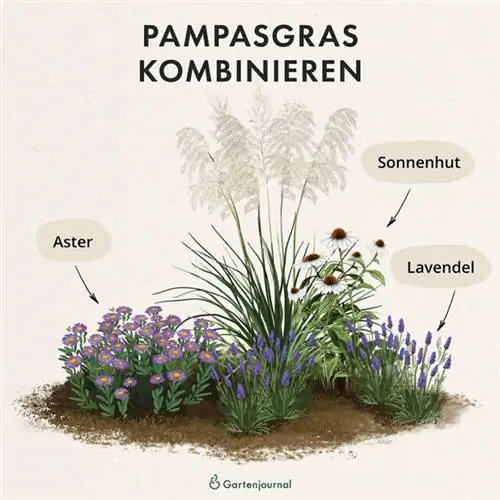
read more
Drying and dyeing pampas grass
If you don't want to part with the flowers in late summer, you can simply harvest and dry them. With the right method, the decorative fronds will last a very long time without pilling. And they are great for coloring. Black pampas grass enchants in its own unique way.
read more
Vases for pampas grass
Once the interior designer has decided on a frond in his favorite color, he still has to choose the right vase. Since the flowers usually have a very long stem, appropriately large vases are recommended. Other dried flowers such as poppy or lavender can be combined with pampas grass.
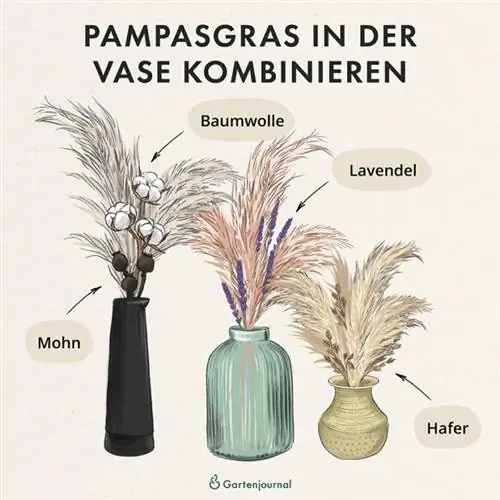
read more
Pampas grass wreaths
With enough flowers you can also make a beautiful wreath out of pampas grass. As a decorative element, it hangs on the front door or stands leaning against the window. Tip: For a rustic Christmas, a wreath made of brownish fronds together with beige candles creates a creative Advent wreath.
read more
FAQ
Is pampas grass hardy?
Yes, pampas grass is considered hardy. But due to the very wet winters in Germany, the pampas grass must be prepared for winter protection.
When can you plant pampas grass?
Pampas grass should only be planted in late spring. It is best to only plant the seedlings when there is no longer any threat of frost after the Ice Saints (mid-May).
Where does pampas grass grow in Germany?
Pampas grass grows all over Germany. In some regions, the pampas grass retains its green color even in winter and does not dry out.
Is pampas grass poisonous?
No, pampas grass is considered non-toxic. However, neither the leaves nor the flowers are edible and should therefore not be eaten.
How big does pampas grass get?
Pampas grass grows to an average height of around 250 centimeters. It reaches over 100 centimeters in width. However, there are much smaller varieties under 100 centimeters.
When is pampas grass cut?
Pampas grass is only cut in late spring when there is no longer any threat of frost.
How fast does pampas grass grow?
Pampas grass grows up to 250 centimeters high in one year - every year again.

